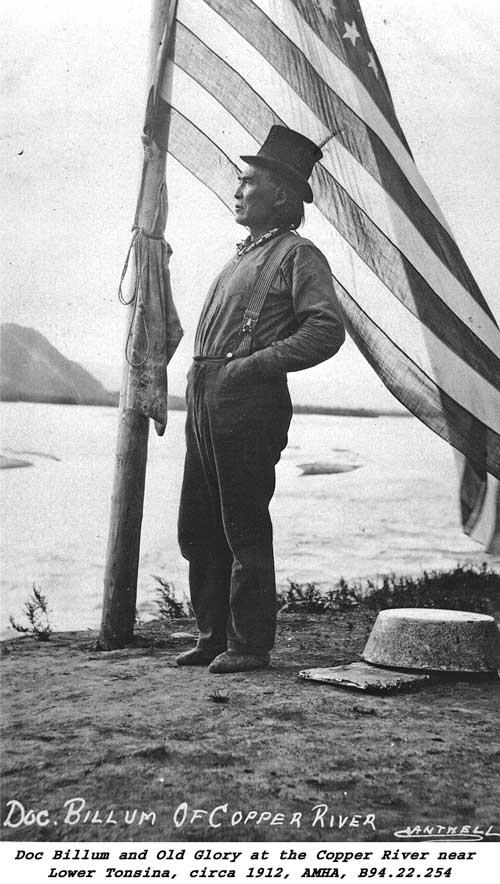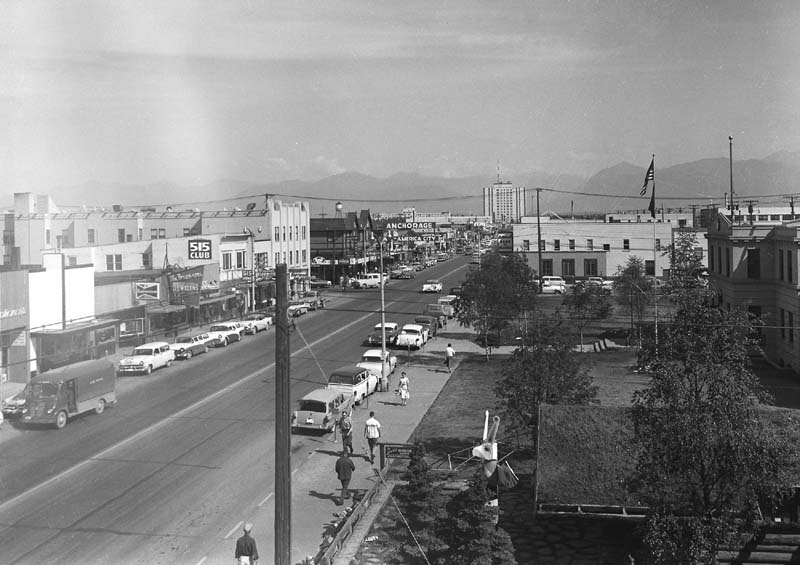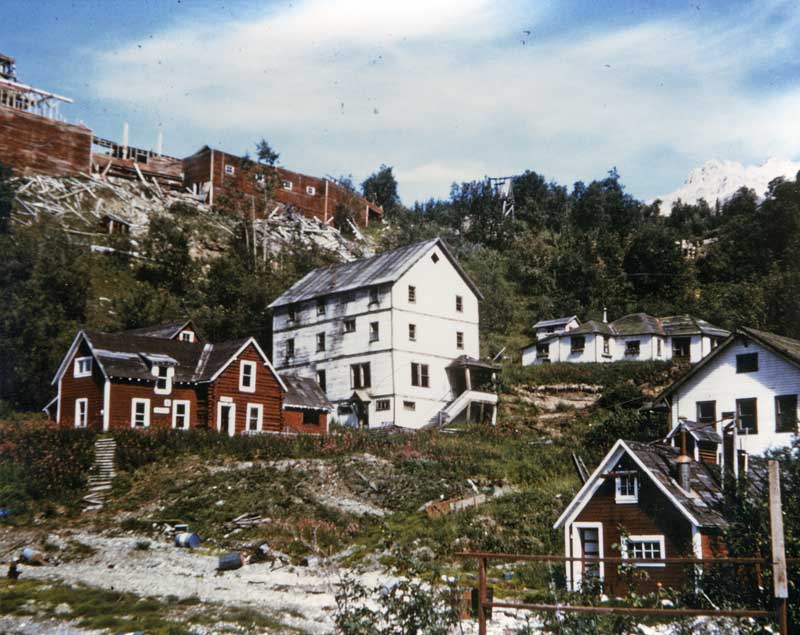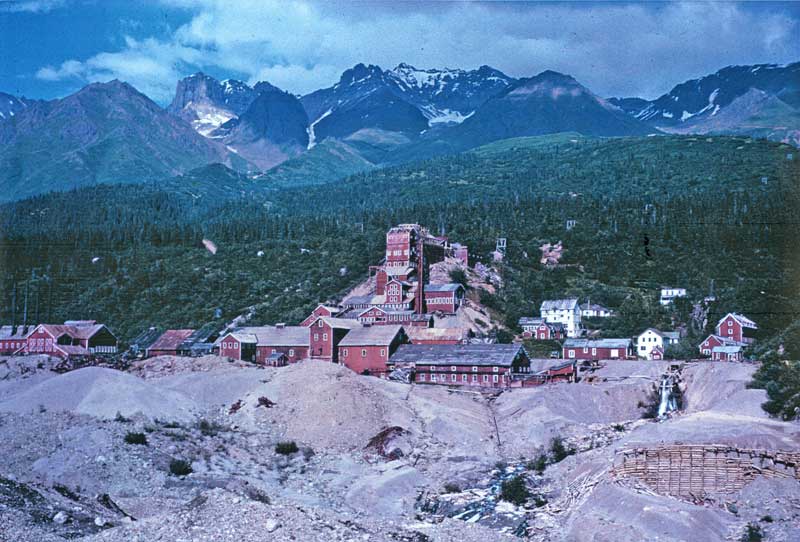 |
| --Anchorage Museum of History & Art (AMHA) |
Why have you forgotten me? asked the Great Creator.
I have given you complete rule over my creation forlong enough. Now you will help my new creatures learn how to live here. You will teach them everything that you know--and especially you will teach them the lesson that Iam not to be ignored.
For I can become easily angered. And I can always rearrange Creation again, as I have just done. You will help teach my new creatures, whom you will know as the Children of the Earth. For it will be up to them to now protect all of
Creation -- the lands and the great waters and the rivers, together with all my creatures which inhabit them. And you will know that if you fail to teach them this important lesson they may destroy you.
But if they destroy you, they will also destroy themselves. For this is the promise that I make to you now. The first of my children which will arrive here I will name the Raven Clan in your honor. And it will fall upon them to see that
Creation is always protected from the foolishness of my other children. You will help them to understand that if they fail in this, I will once again be upset. And you do not want to see me upset again.
--Chief Nicolai the Tyone telling his Raven Story of Creation to three of his grandsons at the abandoned Spirit Camp of Taral across the Copper River from the new town of Chittyna in 1910.
 |
 |
| Kennecott mill in the late 1960s --UAF AK & Polar Regions Photo Archives |
The solitary, cable-operated D-6 dozer moved its way across the shallow crossing at National Creek, just upstream from the deteriorating railroad trestle and downstream from the greying hospital and fading assay office. Lars Erickson was in charge of this new milling and mining operation here at the old mill site.
He had just completed signing the deal with company which owned the mill site -- taking over the process which had been started by Trashman Ray. Lars first met the Trashman in the Chitina area about six years ago.
Ray first learned of the old mill and mine site site back in the late 1950s. He saw an opportunity sitting in tons of salvageable material. Ray immediately contacted the company about the possibilities for stripping the place. At the time the property was under the control of Bear Creek Exploration, a Kennecott subsidiary. The site not been used since final abandonment in 1951 when the last caretaker had been removed. The old buildings were still stacked with enormous piles of salvageable items from copper wire and brass fittings to iron stock. But of even greater interest were the nearly uncountable quantities of personal use items dating back almost to the beginning of the century. Most valued were the china and other house wares, including an large stock of antique furniture and wood-burning stoves. Every cottage was completely furnished and ready to be re-occupied, including the highly coveted Birch and Douglass homes, which contained many items that had become increasingly rare. Ray intended to change all that.
For reasons that were never very clear, the go-ahead was given to make a deal with Ray Trotuchau--Trashman Ray. It has been speculated that the company wanted to find a way to escape the potential liability of a mining and milling site which remained completely open to anyone who wanted to take the trouble to enter the area.
Part of the deal included a commitment on the part of the Trashman to close the mine adits. More significantly, he was to destroy the entire camp at Kennecott, starting with the mill. The Trashman paid a thousand dollars down and began the process of demolition by ripping up the rails between McCarthy and Kennecott so that easy access by the speeders was eliminated.
Ray obtained surface rights to the property, which included the right to remove any ore which existed in talus slides or waste ore dumps or in other places which did not require entering the underground workings. Kennecott reserved for itself all minerals still underground, even though its own reports indicated that no minerals of any economic importance existed there .
Ray and his crew of never-do-wells took over the historic site and began the process of tearing it up and then tearing it down. Ray and the crew were noted by the few locals who still lived in the area for their early morning cocktails to start the day and for their pot-smoking habits. This was reflected in the almost unholy damage they did to each place as they moved from cottage to cottage after first stripping the extensive company store of its remaining treasures.
The power plant and mill had a tantalizing amount of brass fittings as well as some motors and tools of value, which this crew from hell began to strip in a haphazard manner. They accomplished this only after stripping out the most readily removable items. It took years to complete the process, partly because of the cost and effort required to ship the loot out of the area. But also because the crew was underpaid and essentially useless. Nevertheless, in the end the damage was done.
But the deals the Trashman made could not sustain his extravagant gambling habits. While his underpaid and unmotivated crew was slowly stripping the site of its unique personality, Ray played the big shot in Anchorage. He would sit in the Panhandle, drinking cheap vodka and smoking nickel cigars while gambling.
It was a crisp day in the late winter of 1963 when he found himself playing another losing hand at the Panhandle Card room. He looked up in time to see the co-owner of Chitina Air walk in.
“Lars, I know I owe you money for all those flights hauling out my salvaged goods, but the junk is not bringing the prices I expected. Can I talk you into running another load for me so I can get some money to pay you?”
Lars looked at the would-be big shot in quiet disgust. He had let himself get talked into flying out some of the lighter goods to Cordova for shipment to Seattle for some quick funds, but the money was never there. It was not long before Ray quit paying for the air service. Lars had accumulated his own debt as a result of all this flying. His wife had given him an ultimatum. It was time to try to make a turn-around on this operation. This was the moment to begin.
“I tell you what I think, Ray. This operation of yours isn’t working. We’ve been hauling load after load out of McCarthy without compensation. Sometimes I’ve flown in and waited hours for your useless crew to appear with its load. They’ve been tying up my time, and you’re never there to help. Not only are you not paying me, but I’m finding myself putting my own money into this so we can keep on operating.
“I’ve gotten together a group of investors who think there may be some real value in all that copper ore still lying around, and we want to buy your interest out.
“You mean you want in as a partner?” Trashman Ray asked with a look of drunken confusion.
“No. I mean we want you out of there. Look at you. What good could you possibly be to any business enterprise? You’ve already taken a big opportunity and gambled it away. We can’t use you, but we’re willing to assume the debts you’ve racked up, plus a little more for your time. I’ve checked with Bear Creek. They want the money you’ve promised and not delivered, or they’re foreclosing. We’re offering you a way out. What do you want to do?”
Ray could hardly miss the exasperation in the eyes of the youthful, determined, no-nonsense, Scandinavian standing in front of him. Ray had to avoid shutting down his cash flow, but Lars was forcing his hand. He set down his cigar and took a large sip of the vodka. Then he started hacking.
“Ray, you all right? Didn’t’ mean to kill you. Not just yet, anyway.”
Ray’s coughing fit lasted for an uncomfortably long time. His alcohol-drenched world was closing in on him fast. His health was about to fail completely. Years of living as a human parasite were about to catch up. He had to come up with a number.
“Make your deal with Kennecott, Lars. Pick up the mining rights you want. I’ll sign off for 5,000 dollars. You assume the debts already incurred. I still need a little more time to complete my salvaging. I need access to the property maybe another season or so. We’ll still need the use of your air service to fly out our salvaged pieces. We’ll stay out of your way while my crew is stripping the rest of the junk I’ve already pre-sold. At the end of the next season, if we’ve finished, we’ll be gone.”
Lars took a long thoughtful look at the gaunt, smelly, uncouth, thoroughly disgusting and otherwise loathsome creature in front of him.
Pre-sold. Right. Trashman just wants to grab as much as he can while he’s still there. Might as well give a divorced wife the keys to the husband’s house.
“Let’s see if I understand this. I pay you five grand, let you keep stripping the mill site of everything of value, fly out the loot for free because you probably won’t pay me anyway, pay off all your obligations, and after a year you promise to leave, unless that’s not enough time, and it probably won’t be.”
“Yes, Trashman Ray smiled in his most evil, revolting manner. That’s it. If your investors want it bad enough, they’ll deal. If not, I can stretch things out anyway. I can always find another way to get the salvage out of there and never pay you off, just like I never paid anyone else off. Go talk to them and see how badly they want in. You know where I’ll be.
“So what about another flight?” Ray asked as Lars walked out the door.
Lars was only too relieved to get away from that unbelievably sleazy character. He couldn’t imagine how he had let himself get in this far, except perhaps that his own greed on seeing the vast treasures that waited to be claimed at Kennecott, might have gotten the better of him.
Lars turned east, and headed down Fourth Avenue toward the Scandinavian Club Bar. The name intrigued him, since he was a second-generation Norwegian from Minnesota. He headed toward the bar, thinking he needed a good stiff Canadian Club.
Lars felt as though he had become a significant part of the evil which had been spreading over the Chitina Valley lately. Dealing with Ray must have been like dealing with the Devil himself. Everything Ray touched turned to . . . well, it wasn’t a pretty sight. Yet the man who reminded him of Count Dracula and was undoubtedly a close relative of the vulture, was able to keep even the mighty Kennecott Corporation eating out of his shriveled, claw-like hand. Lars had been touched by Ray and he didn’t like it. He was contaminated. Lars ordered himself a double-shot.
 |
| Above: Downtown Anchorage in the late 1950s |
| Below: Anchorage after the '64 earthquake. |
 |
The earthquake which followed that meeting between Lars and Ray had taken what was left of the last remnants of a dying western frontier. The great earthquake of 1964 marked a sharp divide between the old Alaska and the new one which would arise out of the rubble.
After his meeting with Ray and the subsequent meeting with Lars’s potential investors, Lars flew back to Chitina, where he and a partner ran their small air service off One Mile Lake, the first of the three small lakes which were in the narrow valley leading north out of Chitina. That’s when the big earthquake struck. While devastating Anchorage, Valdez and Seward, the quake had left the old railroad area and Kennecott relatively untouched. The most notable exception was the damage to the Million Dollar Bridge, which was severely damaged at pier number three, causing the northern-most span number four to fall into the Copper River.
The main effect would not be apparent until several years later, when it finally became evident that the damage to this bridge and the other steel bridges at Round Island and Flag Point had ended forever the long-planned extension of the Copper River Highway from Cordova to Chitina along the original railroad bed.
But that was of no concern to Lars. He looked up to the mill from where he had stopped the D-6 dozer. All those years of abandonment followed by the largest earthquake ever known to have hit North America had hardly fazed these buildings. Granted, there had been wind and water damage, and the old carpenters’ shop roof had finally succumbed to a snow load, but most of this now long deserted town had stood up to the elements remarkably well until the Trashman had arrived.
Since Lars had first approached Ray, the Trashman’s crew had moved on in their grim and almost sadistic manner, nearly succeeding in destroying this mill by stripping off its roof and top floors as well as almost all of its 200-plus windows. The Trashman had done nearly as much damage to the large company store and warehouse when his crew tore off the west roof and ripped out the oak flooring after stripping the place of almost everything which could be flown out. This had been their final act of mutilation at the place where a proud site had once stood only a few years before.
Ray had succeeded in his evil deeds, but now he was slowly and painfully dying from his own excesses. He took what he could grab and faded into history along with the likes of characters such as John Read and so many of the others who had come to the Great Land only to take from it and then run.
It was a typical interior Alaska summer day. Except for the noise of the moving dozer underneath him, it was quiet out in National Creek. Lars worked his way up from the camp which had been established in the old west barracks on the south end. He stopped the dozer to look up at the windowless and roofless mill. Only a few years before, when Lars first confronted Ray at the Panhandle, the mill had been perfectly intact. It now stood out as a jagged ruin, prematurely aged, forlorn and forgotten, left to the whims of men who were determined to wring yet more money out of the enormous piles of copper waster ore rejected by the Kennecott engineers thirty years before. These were men who could see no value in the historic engineering achievements that these structures represented. To the investors--men who had no understanding of the nature of mining in Alaska--their mining activity was a low-budget operation which would use what it could and destroy what was in the way. Some of these buildings were an impediment and a nuisance to be removed because they stood in the wrong place.
 |
| The Staff House & Superintendent's Residence await their fate. Above, the mill roof has already been torn down. --Charlie Ricci |
The windowless and doorless mill still dominated the skyline from the road bed which once supported two rows of standard-gauge railroad tracks. Even Lars had to stop his noisy dozer to appreciate the faded majesty that this old building still represented.
Trashman and his other carrion-eating vermin are finally gone. Now to the real business of mining that million dollars worth of ore up there at the Bonanza mine site.

No comments:
Post a Comment